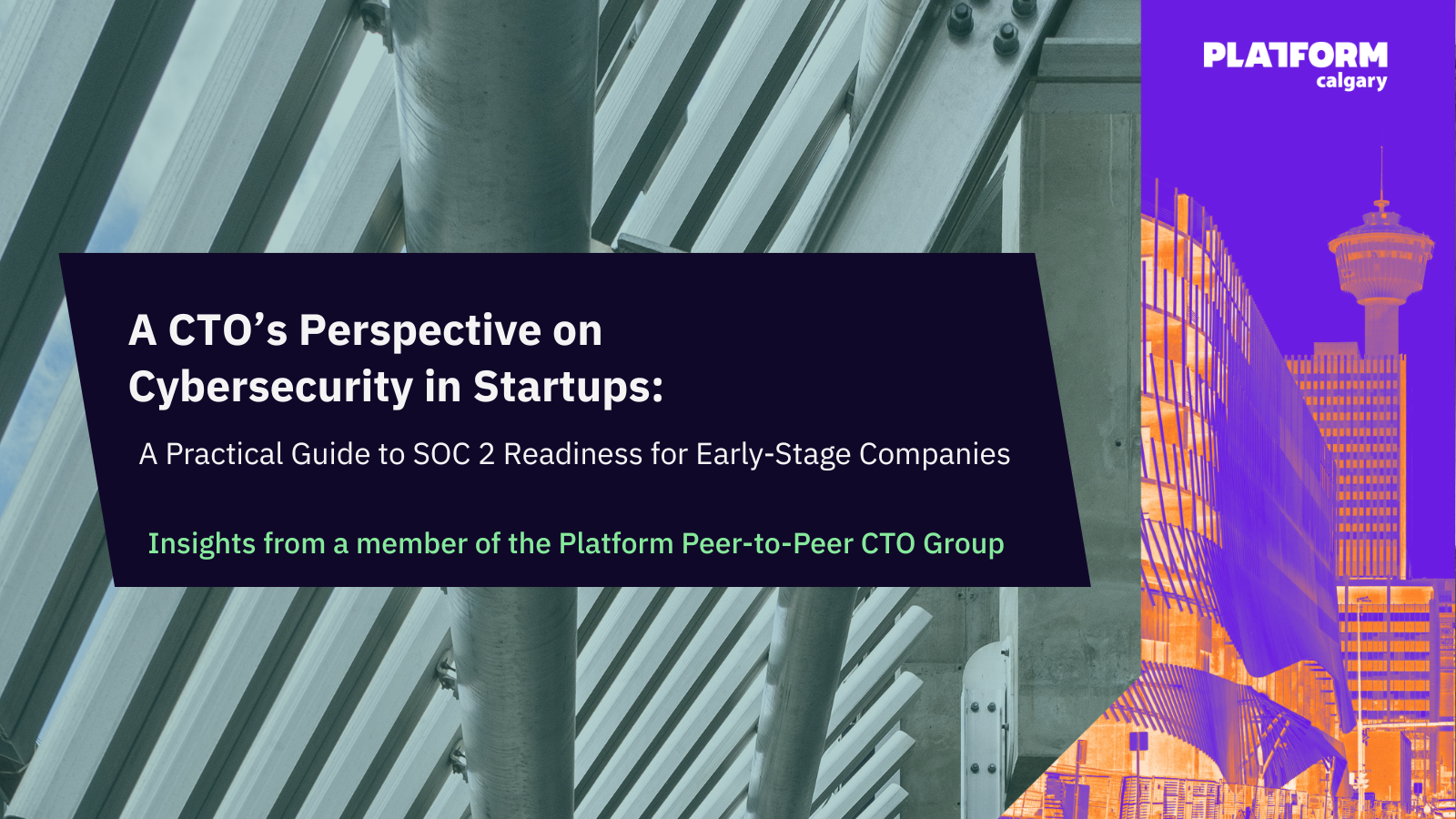A CTO’s Perspective on Cybersecurity in Startups: A Practical Guide to SOC 2 Readiness for Early-Stage Companies

Platform Calgary is a non-profit, member based organization. Our mandate is to bring together the resources of Calgary's tech ecosystem to help startups launch and grow at every step of their journey, from ideation through to scale.
More about Platform CalgaryBy Rubén Amórtegui, P.Eng., MIT-Certified Technology Executive, GWAPT Certified, GIAC Advisory Board Member, Chief Technology Officer at SAGA Wisdom
In today’s digital age, cybersecurity has become a cornerstone of business success. Organizations with established security processes often require their vendors to demonstrate a formal security posture as part of their due diligence. This process can be daunting for startups, as it involves providing evidence of security measures, processes, and continuous evaluation.
According to Nasstar, implementing robust cybersecurity measures is crucial for businesses to protect sensitive data and maintain operational efficiency (Nasstar, 2025) [1].
What Is SOC 2 Compliance?
SOC 2 (System and Organization Controls) is a set of standards developed by the American Institute of Certified Public Accountants (AICPA). It evaluates how well a company manages its risks related to different Trust Service Criteria, such as security, availability, processing integrity, confidentiality, and privacy.
For startups that rely on customer data or provide cloud-based services, achieving SOC 2 compliance demonstrates a commitment to robust cybersecurity practices, with security being the most commonly sought requirement.
Why SOC 2 Matters for Startups
A cybersecurity posture is fundamental for protecting assets and building trust with stakeholders, which is essential for attracting customers and investors. By implementing SOC 2 standards, startups can establish a framework that ensures data security, operational integrity, and compliance with regulations. However, the journey to SOC 2 compliance often proves more challenging than expected. The process involves audits, documentation, and continuous monitoring of controls.
Some common challenges include:
- Resource Constraints: Startups often lack dedicated cybersecurity teams or a budget for expensive tools.
- Complexity: Understanding and implementing the specific requirements of SOC 2 can be overwhelming.
- Cultural Shifts: Fostering a security-first mindset across the organization requires time and effort.
Key Benefits of SOC 2 Compliance
Despite these challenges, proactively addressing SOC 2 compliance offers significant advantages that can outweigh the initial effort:
- Trust and Credibility: A SOC 2 report assures customers and partners that their data is secure, processes are in place for business continuity, and there is a willingness to improve continuously. It is also one of the most recognized compliance standards for building trust and winning business (Vanta, 2025) [2].
- Market Differentiation: SOC 2 compliance can provide a competitive advantage, as customers and enterprise partners are more likely to do business with organizations that can be trusted with sensitive data (Palo Alto Networks, 2025)[3].
- Risk Mitigation: By identifying and addressing vulnerabilities, startups reduce the likelihood of costly breaches. SOC 2 compliance reinforces this effort by requiring continuous risk assessments and control monitoring, helping organizations proactively manage threats before they escalate (Drata, 2025)[4].
Practical Strategies for CTOs and Startup Leaders
As a CTO in a startup, you will wear different hats, and the experience may differ across organizations. Still, if there’s no dedicated cybersecurity professional, the CTO is typically a good candidate to be responsible for handling it. Here are some strategies to approach SOC 2 compliance effectively:
- Start Early
Conduct a preliminary gap analysis of your security practices against SOC 2 requirements. This involves documenting existing policies, procedures, and technical controls and identifying where they fall short. Prioritize the Trust Services Criteria most relevant to your business (e.g., security, availability, or confidentiality) and focus initial efforts there.
- Leverage Automation
Utilize Security Information and Event Management (SIEM) systems to automate log monitoring and threat detection; if not, use the tools from your cloud provider. Implement automated vulnerability scanning tools to regularly identify and assess security weaknesses. Employ compliance management platforms like Drata or Vanta to streamline the audit process and automate evidence collection, policy tracking, and reporting.
- Involve Your Team
Conduct regular security awareness training sessions for all employees, covering topics such as phishing, password security, data handling, and incident reporting. Establish clear communication channels for reporting security incidents or concerns. Integrate security considerations into the software development lifecycle (SDLC) through secure coding practices and code reviews.
- Focus on Continuous Improvement
Establish a process for regular security audits and reviews, not just for the SOC 2 audit but as an ongoing practice. Implement a system for tracking and addressing security vulnerabilities and incidents. Monitor changes in regulations and update security practices accordingly.
- Prioritize Transparency
Communicate your security posture and SOC 2 progress with customers, investors, and employees through regular updates and reports. Be open about security incidents and how they were addressed. Maintain clear documentation of security policies and procedures, and ensure they are accessible to relevant parties.
Key Areas to Strengthen for SOC 2 Readiness
For readiness, leveraging services with external providers like Drata or Vanta will help centralize information for compliance and maintain documentation and evidence in the same place. To effectively implement these strategies, startups should focus on key organizational areas or working items like:
- Organizational Policies:
Track and review your policies periodically to adjust them according to business needs. Examples include an acceptable use policy, asset management policy, backup policy, business continuity plan, code of conduct, data classification, and disaster recovery plan.
- Personnel:
Onboarding, policy acknowledgment, MFA, Background Check, Security Training, Device Compliance.
- Risk Assessment:
Ongoing evaluation of company risk posture
- Vendors:
Perform due diligence to ensure vendors comply with relevant regulations and maintain an acceptable security posture.
- Assets:
Understand your physical and non-physical devices, their owners, accesses, and who is responsible as a custodian vs. an owner of the information. Comply with the risk level the company tolerates.
- Vulnerabilities:
Identify, Classify, Document, and evaluate your system vulnerabilities, and align your risk tolerance and resolution timelines with your security policies
Final Thoughts: SOC 2 as a Strategic Investment
By understanding the SOC 2 framework, addressing its challenges, and implementing proactive strategies, startups can establish a strong security foundation for sustainable growth. While requiring upfront investment, prioritizing SOC 2 compliance is a strategic move that minimizes risk and positions startups for sustainable growth in a competitive market. It should be more than just a checkbox; it’s a strategic investment in building trust and ensuring long-term success. That said, the decision depends on your available resources and specific business needs, so if you can wait to get the SOC 2 audit, focus on using the industry standards. You will be in good shape when the time comes for an audit.
[1] Nasstar. (2025). Why cyber security is important for businesses. Retrieved April 11, 2025, from https://www.nasstar.com/hub/blog/why-cyber-security-is-important-for-businesses
[2] Vanta. “SOC 2: The Most Accepted Compliance Standard.” Accessed April 11, 2025. https://www.vanta.com/collection/soc-2/soc-2-most-accepted-compliance-standard
[3] Palo Alto Networks. “What Is SOC 2?” Cyberpedia, accessed April 11, 2025. https://www.paloaltonetworks.ca/cyberpedia/soc-2
[4] Drata. “SOC 2 Compliance Checklist: How to Prepare.” Accessed April 11, 2025. https://drata.com/grc-central/soc-2/compliance-checklist
About Platform Peer-to-Peer Program
The Peer-to-Peer Program connects individuals with same roles and responsibilities at local tech companies, providing them the space to network, problem solve, and share knowledge with one another.
Published on
August 22, 2025
Tags
Explore more posts

For Investors
Uncharted Capital: What We Heard, What We Built, and What’s Ahead
Over the past year, we’ve explored the realities of fund building in Canada: how to design a thesis that actually reflects your edge, how to construct a portfolio that makes sense in this market, how to engage diverse founders in ways that are meaningful and not performative, how to measure impact without falling into the traps of vanity metrics, and what emerging managers needs to know about securities law.

For Startups
Celebrating Platform Incubator Cohort 4: A Year of Growth, Grit, and Game-Changing Momentum
Over the past 12 months, the founders in Platform Incubator Cohort 4 proved exactly what’s possible when determination, discipline, and community come together. These entrepreneurs navigated uncertainty, refined their products, pursued market clarity, and pushed their companies forward with conviction—and the results speak for themselves.

For Investors
What Emerging Managers Need to Know About Securities Law
For this chapter, Audaxa Ventures sat down with the investment management law team at the Calgary office of Borden Ladner Gervais LLP (BLG) to unpack the legal journey every emerging fund manager faces. We approached this conversation not as lawyers, but as operators, asking the questions we wish someone had answered before our first close.






